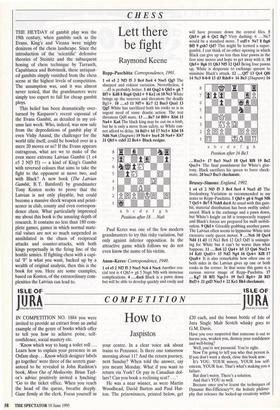CHESS
Lett there be fight
Raymond Keene
THE HEYDAY of gambit play was the 19th century, when gambits such as the Evans, King's and Vienna were mighty denizens of the chess landscape. Since the introduction of the 'scientific' defensive theories of Steinitz and the subsequent honing of chess technique by Tarrasch, Capablanca and Botvinnik, these antiquat- ed gambits simply vanished from the chess scene at the highest levels of competition. The assumption was, and it was almost never tested, that the grandmasters were simply too expert to fall for cheap gambit ploys.
This belief has been dramatically over- turned by ICasparov's recent espousal of the Evans Gambit, as detailed in my col- umn last week. Who, indeed, was now safe from the depredations of gambit play if even Vishy Anand, the challenger for the world title itself, could be bowled over in a mere 20 moves or so? If the Evans appears outrageous, what are we to make of the even more extreme Latvian Gambit (1 e4 e5 2 Nf3 f5) — a kind of King's Gambit with reversed colours that aims to take the fight to the opponent at move two, and with Black? A new book (The Latvian Gambit, B. T. Batsford) by grandmaster Tony Kosten seeks to prove that the Latvian is not only playable, but could become a massive shock weapon and point- scorer in club, county and even correspon- dence chess. What particularly impressed me about this book is the amazing depth of research. It contains no less than 180 com- plete games, games in which normal mate- rial values are not so much suspended as annihilated in the chaos of reciprocal attacks and counter-attacks, with both kings perpetually in the firing line of the hostile armies. If fighting chess with a capi- tal 'F' is what you want, backed up by a wealth of original analysis, then this is the book for you. Here are some examples, based on Kosten, of the extraordinary com- plexities the Latvian can lead to. Repp-Paschitta: Correspondence, 1991.
1 e4 e5 2 N13 f5 3 Bc4 ete4 4 Nxe5 Qg5 The sharpest and riskiest variation. Nevertheless, 4
d5 is probably better. 5 d4 Qxg2 6 Qh5+ g6 7 1317+ Kd8 8 Bxg6 Qxhl + 9 Ke2 c6 10 Nc3 White brings up the reserves and threatens the deadly Bg5+ . 10 ... e3 11 Nf7+ Kc7 12 Bxe3 Qxal 13 Qg5 White has sacrificed both his rooks so is in urgent need of some drastic action. The text threatens Qd8 mate. 13 ...Be7 14 Bf4+ Kb6 15 Na4+ Ka6 The black king may be out on a limb, but he is only a move from safety, so White can- not afford to delay. 16 Bd3+ b5 17 Nc5+ Kb6 18 Nd6 Na6 (Diagram) 19 Nc4+ bxc4 20 Na4+ Kb7 21 Qb5+ cxb5 22 Be4+ Black resigns.
Paul Keres was one of the few modern grandmasters to try this risky variation, but only against inferior opposition. In the attractive game which follows we do not even know the name of his victim.
Anon-Keres: Correspondence, 1940.
1 e4 e5 2 Nf3 f5 3 Nxe5 Nc6 4 Nxc6 Another cru- cial test is 4 Qh5+ g6 5 Nxg6 Nf6 with immense complications. 4 ... dxc6 Black is a pawn down but will be able to develop quickly and easily and will have pressure down the central files. 5 Qh5+ g6 6 Qe2 Bg7 Very dashing: 6 ...Ne7 would be a standard move. 7 exf5 + Ne7 8 fxg6 Bf5 9 017 Qd7 This might be termed a super- gambit. I can think of no other opening in which Black can give up no less than four pawns in the first nine moves and hope to get away with it. 10 Qh5+ Bg6 11 Qh3 Nf5 12 Qd3 Being four pawns up, White is desperate to exchange queens to minimise Black's attack. 12 ... Q17 13 Qc4 Q16 14 Nc3 0-0-0 15 d3 Rde8 + 16 Be3 (Diagram) 16
Position after 16 Be3
...Rxe3+ 17 fxe3 Nxe3 18 Qa4 It18 19 Be2 Qxc3+ The final punishment for White's glut- tony. Black sacrifices his queen to force check- mate. 20 bxc3 Bxc3 checkmate.
Brusey—Simons: England, 1992.
1 e4 e5 2 ND f5 3 Bc4 fxe4 4 Nxe5 d5 The Svedenborg Variation as recommended in my notes to Repp—Paschitta. 5 Qh5+ g6 6 Nxg6 Nf6 7 Qe5+ Be7 8 Nxh8 dxc4 As usual with this gam- bit, material distribution has been swiftly unbal- anced. Black is the exchange and a pawn down, but White's knight on h8 is temporarily trapped and Black's forces are prepared for swift mobili- sation. 9 Qb5+ Greedily grabbing another pawn. The Latvian often seems to hypnotise White into excessive early queen moves. 9 ... Nc6 10 Qxc4 Nd4 11 d3 11 Na3 Be6 12 Qc3 Qd5 is uninspir- ing for White but it can't be worse than what happens. 11 ...Be6 12 Qa4+ b5 13 Qa6 Nxc2 + 14 Kdl Qxd3 + 15 Nd2 Ng4 16 Qc6+ K18 17 Qxa8+ It is also remarkable how often one or both sides in the Latvian gives up one or both rooks in the corner. In that sense this game is a curious mirror image of Repp—Paschitta. 17 ...Kg7 18 Rfl Nge3+ 19 fxe3 Bg4+ 20 RD Bxf3 + 21 gxf3 Nxe3+ 22 Kel Bh4 checkmate.


































































 Previous page
Previous page